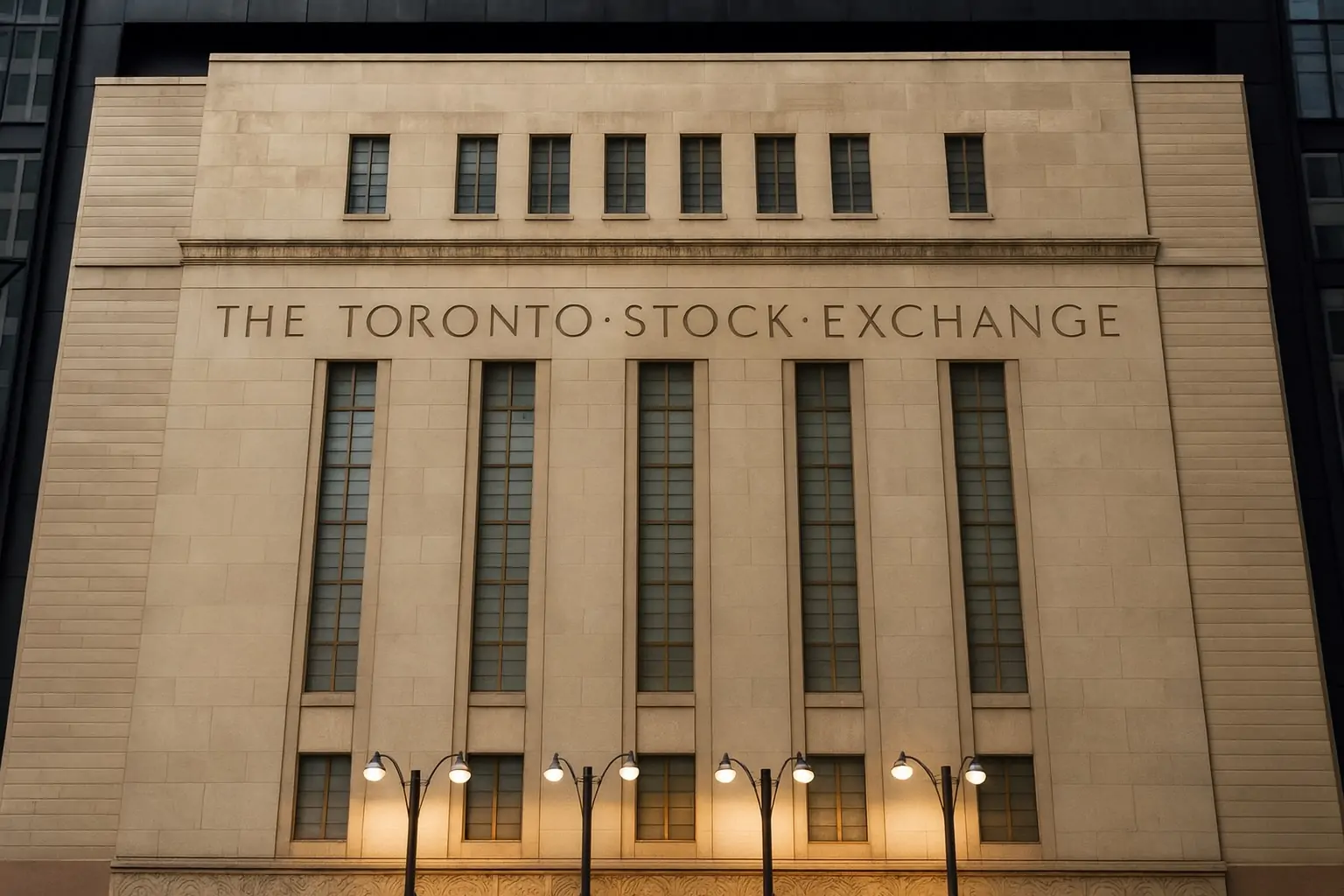The Canadian stock market steadied on Friday, November 21, 2025, as the S&P/TSX Composite Index clawed back some of Thursday’s steep losses. By the close, Canada’s main benchmark was up about 0.2%, finishing near 29,962 points, according to Trading Economics data, a modest rebound after a brutal 1.2% drop the day before. [1]
Investors on Bay Street spent the session balancing weak Canadian retail sales, sliding oil prices, and ongoing anxiety about an AI-led tech bubble against rising odds of a December interest-rate cut by the U.S. Federal Reserve. [2]
TSX Today: Small Rebound After a Rough Week
On Thursday, the S&P/TSX Composite had tumbled 371.86 points, or 1.23%, to 29,906.55, its weakest close in roughly two weeks, as profit‑taking and fears over stretched AI-related valuations hit global equities. [3]
On Friday, the tone was more cautious than euphoric:
- Mid-morning: Reuters reported the index was up around 0.1% at 29,965.88 by 10:21 a.m. ET, with broad-based gains offset by a sharp slide in energy stocks. [4]
- Late morning: A Canadian Press report noted the S&P/TSX Composite was ahead by 82 points at 29,988.78, tracking a stronger Wall Street open. [5]
- By the close: Trading Economics data show the TSX ended the day near 29,962, up 0.19% versus Thursday’s finish, trimming but not erasing this week’s roughly 1.2% pullback. [6]
Even with Friday’s bounce, the index was still on course for its weakest weekly performance since early October, underlining how quickly sentiment has swung since the TSX notched a record high above 30,800 earlier this month. [7]
Macro Backdrop: Weak Retail Sales, Softer Housing and Dovish Fed Signals
Canadian data: consumers and housing flashing “slowdown”
Two key Canadian data points framed today’s trade:
- Retail sales:
- Down 0.7% month‑over‑month in September, to about C$69.8 billion.
- Volume sales fell 0.8%, indicating fewer goods actually sold, not just lower prices.
- The weakness was driven largely by motor vehicle and parts dealers, while sales excluding autos and parts rose 0.2%, suggesting some resilience in core spending.
- Year‑on‑year, retail sales were still up 3.4%, but a flash estimate suggested October was flat, reinforcing the idea of a cooling consumer. [8]
- Housing prices:
- Final data showed the Canadian House Price Index fell 0.4% in October, a deeper decline than the 0.2% drop in September, even as new‑home price indices remain in negative territory on a yearly basis. [9]
These figures came on the heels of October CPI showing inflation at 2.2% year‑over‑year, down from 2.4% in September, which supports the narrative of easing price pressures but sluggish real activity. [10]
For equity investors, the combination of softer retail spending, a cooling housing market and moderating inflation feeds a familiar question: Are rate cuts coming because growth is slowing more than expected?
U.S. Fed: “Near-term” rate cut hopes fuel risk appetite
The other side of the macro equation came from Washington and New York:
- New York Fed President John Williams said the Fed could still cut rates “in the near term” without jeopardizing its inflation target, reinforcing expectations of a December rate cut. [11]
- Futures markets now see over a 70% chance of a 25‑basis‑point cut next month, up sharply from earlier in the day. [12]
- Globally, a Bank of America flow report highlighted that tech stocks remain on track for a record US$75 billion of inflows in 2025, even as investors openly debate whether AI‑related names are in bubble territory. [13]
This mix — soft Canadian data but more accommodative Fed expectations — helped stabilize risk sentiment on Bay Street, even as oil and silver prices sagged.
Sector Snapshot: Tech and Financials Up, Energy and Miners Under Pressure
Tech & growth: Shopify and AI sentiment
According to Trading Economics commentary, Shopify was among the day’s standout performers, rising more than 2% and helping to pull the technology sector modestly higher. [14]
This comes against a tricky backdrop for anything AI‑adjacent:
- Global markets have been whipsawed by concerns that AI spending and valuations are running ahead of fundamentals, sparking a sharp tech-led selloff earlier in the week. [15]
- On Thursday, those worries helped drag the TSX to that 1.23% decline, closely mirroring a choppy session on Wall Street. [16]
Friday’s gains in Shopify and other growth names suggest investors are still willing to buy dips in high‑quality Canadian tech, even as they become more selective about AI-heavy bets.
Big banks and asset managers: Quiet support
Large financials provided steady ballast:
- Royal Bank of Canada, TD Bank, Bank of Montreal and Brookfield all posted gains generally in the 0.7%–1.3% range during the session, according to Trading Economics’ intraday commentary. [17]
Given their outsized weight in the index, even modest moves in these names can meaningfully support the TSX, especially on days when cyclical sectors are underperforming.
Energy: Oil slump drags heavyweight producers
The biggest drag on the TSX on Friday was the energy sector, which fell more than 1.5%, according to Reuters. [18]
The pressure came from oil:
- WTI crude traded around US$57–58 per barrel, extending a third straight day of declines.
- A key driver is renewed U.S. diplomatic pressure for a Russia‑Ukraine peace deal, which markets interpret as potentially unlocking more supply and reducing the geopolitical risk premium embedded in oil prices. [19]
Against this backdrop, Canadian Natural Resources and other big energy names were cited as notable losers, each down by a little over 1% in Trading Economics’ midday snapshot. [20]
Gold miners: Still stars of 2025, but taking a breather
Despite Friday’s weakness in some mining names, gold producers remain one of the TSX’s best-performing groups in 2025:
- Reuters notes that gold miners on the TSX are up more than 110% year‑to‑date, reflecting a powerful rally in bullion amid geopolitical risk and rate‑cut speculation. [21]
On the day, however, Agnico Eagle and other precious‑metal names slipped as investors locked in profits, even with spot gold holding firm to slightly higher on renewed Fed cut hopes. [22]
Stock Stories to Watch: Dye & Durham, GFL Environmental, Baylin Technologies
Dye & Durham soars on go‑private offer chatter
One of the biggest movers on the Toronto Stock Exchange today was Dye & Durham (TSX: DND):
- Reuters reported that the legal‑software company’s shares jumped about 16% after a media report said Plantro had offered roughly US$272 million to take the company private. [23]
- A MarketScreener summary of earlier coverage cited a C$5.72‑per‑share proposal valuing the deal at around C$384 million, depending on how debt is treated. [24]
- In a mid‑day news release, Dye & Durham confirmed it had received an unsolicited proposal, but stressed that no agreement has been reached and no transaction is guaranteed, responding to questions from the Canadian Investment Regulatory Organization (CIRO). [25]
The move turned DND into a speculative focal point on Bay Street, highlighting continued private‑equity interest in cash‑generative Canadian software assets, even in a higher‑rate environment.
GFL Environmental dips on C$750 million secondary offering
Waste‑management and environmental services giant GFL Environmental (NYSE/TSX: GFL) traded lower after a significant share sale:
- Several major shareholders priced a secondary offering of 16.6 million subordinate voting shares at US$45.15, raising roughly US$750 million in gross proceeds. [26]
- GFL itself agreed to repurchase about 1.27 million of those shares, partially offsetting the selling pressure from existing holders. [27]
- An Investing.com summary said GFL’s stock was down a little over 2% in early trading following the announcement, reflecting near‑term dilution and technical pressure, even as the company maintains a strong growth and acquisition track record. [28]
For investors, the transaction is largely about liquidity and shareholder rotation rather than a change in GFL’s fundamentals, but it did contribute to muted sentiment in parts of the industrials and ESG‑themed trade today.
Baylin Technologies lands fresh orders
Outside the big index names, there was also action in smaller Canadian tech hardware:
- Baylin Technologies (TSX: BYL) announced it had received C$1.7 million in orders from Tier One Canadian carriers, according to a brief Reuters note. [29]
While the dollar amount is modest, the news reinforces Baylin’s ties with major domestic telecom customers and underscores ongoing 5G and wireless infrastructure investment across Canada.
Energy Micro‑Headline: CSE Delists Andina Copper
On the Canadian Securities Exchange (CSE), Andina Copper Corporation (ANDC) saw its common shares delisted, as per a bulletin published Friday. [30]
Although the company is small and the move doesn’t affect the TSX benchmark, such delistings are a reminder of the ongoing shakeout in junior mining and exploration, especially in a year when investors have favored larger, more established resource names and gold majors.
What Today’s TSX Move Means for Investors
Friday’s session on Bay Street can be read as a fragile stabilization rather than a full‑throated rebound:
- The headline index is back just below 30,000, but weekly performance remains negative, reflecting heightened sensitivity to AI‑related volatility and global macro headlines. [31]
- Domestic data — notably weaker retail sales and soft housing indicators — point to a consumer and property market under pressure, even as inflation slowly drifts toward target. [32]
- At the same time, Fed messaging and market pricing suggest the next major catalyst is a possible U.S. rate cut in December, which could support risk assets globally but may also be a response to slowing growth. [33]
For investors:
- Cyclicals & energy: remain hostage to oil headlines and geopolitics, especially developments around Russia‑Ukraine peace talks. [34]
- Gold and miners: continue to look attractive as macro hedges, though after triple‑digit year‑to‑date gains, volatility and profit‑taking are to be expected. [35]
- Quality tech and financials: still appear to be the steady centre of gravity for the TSX, with names like Shopify and the big banks drawing incremental buyers on down days. [36]
In short, November 21, 2025 on Bay Street was less about a big directional call and more about catching breath after a selloff — with corporate deal activity (Dye & Durham), shareholder rotations (GFL) and selective stock‑picking doing much of the heavy lifting beneath a relatively calm headline index.
References
1. tradingeconomics.com, 2. www.reuters.com, 3. www.finanzen.ch, 4. www.reuters.com, 5. ca.finance.yahoo.com, 6. tradingeconomics.com, 7. www.reuters.com, 8. www.reuters.com, 9. www.finanzen.ch, 10. www150.statcan.gc.ca, 11. www.reuters.com, 12. www.reuters.com, 13. www.reuters.com, 14. www.tradingview.com, 15. www.reuters.com, 16. www.finanzen.ch, 17. www.tradingview.com, 18. www.reuters.com, 19. www.reuters.com, 20. www.tradingview.com, 21. www.reuters.com, 22. www.tradingview.com, 23. www.reuters.com, 24. in.marketscreener.com, 25. www.newswire.ca, 26. www.prnewswire.com, 27. www.marketscreener.com, 28. www.investing.com, 29. www.tradingview.com, 30. www.newsfilecorp.com, 31. tradingeconomics.com, 32. www.reuters.com, 33. www.reuters.com, 34. www.reuters.com, 35. www.reuters.com, 36. www.tradingview.com







